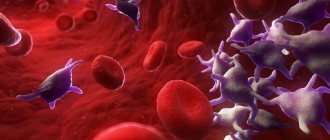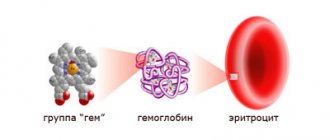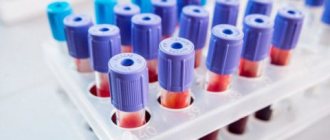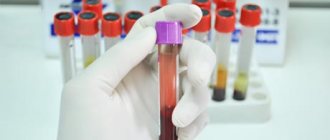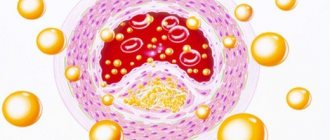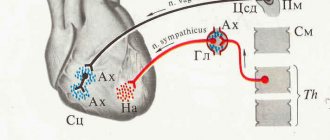If not treated promptly, hyperkalemia can have long-term effects on blood pressure
, heart rate, digestion, and kidney function.
Contact your doctor immediately
if you think you are experiencing hyperkalemia. The main goals of treatment include stabilizing the heart rate and promoting the elimination of potassium from the blood. Typically, the patient is given calcium gluconate, sodium bicarbonate, diuretics, sorbitol or insulin. These drugs work to either move potassium from the blood back into cells or to increase the amount of potassium excreted through urine or feces. In extreme cases, dialysis treatment is used.
The body of a healthy person weighing about 70 kg contains 3150 mmol of potassium (45 mmol/kg in men and about 35 mmol/kg in women). Only 50-60 mmol of potassium is in the extracellular space, the rest is distributed in the cellular space. Daily potassium intake is 60-100 mmol. Almost the same amount is excreted in the urine and only a little (about 2%) is excreted in the feces. Normally, the kidney secretes potassium at a rate of up to 6 mmol/kg/day.
What to consider when assessing the analysis result
Serum potassium concentration is an indicator of its total content in the body, but its distribution between cells and extracellular fluid can be influenced by various factors (acid-base imbalance, increased extracellular osmolarity, insulin deficiency). Thus, with a shift in pH by 0.1, one should expect a change in potassium concentration by 0.1-0.7 mmol/l in the opposite direction.
Physiological function of potassium
Potassium is an important mineral that is necessary for the normal functioning of many human systems and organs. The amount of potassium in the body depends on how much it comes from food, how it is distributed and excreted through the kidneys, intestines and sweat glands.
Why do you need a potassium test?
It is important to control the amount of potassium in the body, since the biological role of this microelement for humans is quite large. Potassium works as an immunomodulator, saturates the brain with oxygen, lowers blood pressure, promotes the elimination of toxins, and helps in the treatment of allergies. A lack of potassium in the body leads to disruption of the functioning of many organs.
Elevated potassium levels in the blood increase the risk of cardiac arrest. Therefore, a potassium test is necessary if the patient suffers from pathologies of the cardiovascular system. Also, the potassium content in the blood may increase due to taking anti-inflammatory, antitumor and other medications. During such drug therapy, the doctor also prescribes a blood test for potassium.
Symptoms and consequences of potassium deficiency
Not having enough potassium in the blood can cause symptoms that range from mild to very severe. The symptoms of hypokalemia are determined by the physiological role of potassium and, therefore, by the electrolyte imbalance that develops when potassium levels decrease.
Among the most common symptoms of potassium deficiency we have:
- Muscle problems: Potassium deficiency causes muscle cramps, tetanic twitching, muscle weakness, decreased reflexes and fatigue in the limbs.
- Bowel problems: Paralytic ileus and mild symptoms such as nausea, vomiting, constipation and a feeling of bloating develop.
- Heart problems: Potassium deficiency leads to problems in the heart such as changes in heart rhythm resulting in the subject suffering from tachycardia, premature beats and ventricular fibrillation.
- Kidney symptoms: Potassium deficiency can lead to polyuria, which is excessive production and excretion of urine (more than two liters) in a 24-hour period, resulting in a persistent feeling of thirst.
- Pressure problems: Potassium deficiency can lead to hypertension due to an altered sodium/potassium ratio that is unbalanced in favor of sodium. But hypokalemia can also indicate low blood pressure due to electrolyte imbalance.
- Psychological symptoms: Electrolyte imbalance caused by potassium deficiency can lead to depression or delirium, confusion or hallucinations.
Warning: the consequences can be seriousSevere potassium deficiency can cause heart problems, such as changes in the heartbeat followed by cardiac arrhythmia and left ventricular block, which can lead to cardiac arrest. Paralysis of the muscles as a whole may also occur, which also includes the respiratory muscles and causes respiratory failure. |
Hypokalemia
Potassium deficiency is also observed in renal acidosis, Cushing's syndrome, Fanconi syndrome, primary and secondary aldosteronism, and osmotic diauresis. All these pathologies provoke the excretion of potassium from the body along with urine.
Potassium can decrease when the body loses it through intestinal secretions. This occurs with frequent vomiting, intestinal villous adenoma, severe diarrhea, intestinal obstruction and intestinal fistulas.
A decrease in potassium levels can be caused by the presence of insulinoma or long-term insulin therapy, taking folic acid and vitamin B12 for megaloblastic anemia. A decrease in potassium occurs due to an excess of adrenaline and norepinephrine during prolonged stress conditions, during thyrotoxicosis due to increased levels of thyroid hormones, during the rehabilitation period after severe operations and diseases due to the binding of potassium by the resulting proteins and glycogen.
Causes of hypokalemia – pathological and non-pathological
Now let's look at what could be the causes of low potassium in the blood , what diseases are accompanied by a lack of this electrolyte, and what non-pathological conditions may have an impact on the decrease in potassium levels.
Pathological causes of hypokalemia
Diseases that can lead to hypokalemia include:
- Vomiting and diarrhea: Frequent episodes of diarrhea and prolonged vomiting lead the body to dehydration, that is, the loss of large amounts of fluid, and therefore electrolytes, including potassium. Vomiting and diarrhea are nonspecific symptoms of many diseases. Vomiting can lead to a state of hypokalemia during pregnancy, especially in the first trimester.
- Bartter's syndrome: This is a rare genetic pathology in which there is excessive excretion of fluid and electrolytes through the urine, as a result of altered functioning of the sodium, potassium and chloride reabsorption system at the level of the renal bend.
- Liddle's syndrome: This is a genetic disease that causes high blood pressure and low potassium levels due to defective sodium reabsorption at the renal tubular level.
- Diabetes mellitus: Decreased potassium levels may occur in diabetes mellitus. An increase in blood glucose levels essentially leads to electrolyte imbalance and decreased potassium levels.
- Eating disorders: Conditions such as bulimia and anorexia can lead to hypokalemia due to frequent vomiting.
- Hyperaldosteronism: This is a pathology in which there is a defect in the secretion of the hormone aldosterone, which is produced in excessive quantities and causes a decrease in the level of potassium in the blood.
- Cushing's syndrome: This is a condition in which, for various reasons, excess secretion of glucocorticoid hormones develops. This results in an electrolyte imbalance in the body, in which there is a decrease in potassium levels.
- Severe burns: Severe burns result in loss of fluid and electrolytes in the body due to severe dehydration due to excess heat, and therefore can determine the development of hypokalemia.
Non-pathological causes of potassium loss
There are several causes of hypokalemia that are not pathological:
- Diet: Potassium deficiency can occur due to poor diet, but this is very rare as potassium is found in many foods
- Surgery: Low potassium levels in the blood may occur after some surgical procedures. For example, anti-obesity surgery aimed at reducing nutrient absorption may reduce blood potassium levels with subsequent hypokalemia.
- Medications: Many medications can cause hypokalemia because they affect the body's electrolyte balance. Among them are diuretics, which accelerate the removal of fluids from the body, and therefore also electrolytes; laxatives, which lead to increased loss of water and ions in feces; some antibiotics such as gentamicin and penicillins; insulin therapy.
- Sweating: Excessive sweating, such as after a long workout, without adequate rehydration, can cause potassium deficiency as you lose a lot of salts and minerals through sweat.
- Fasting: Hypokalemia can sometimes be seen due to dietary beliefs, religious belief, or simple lack of appetite due to stress, anxiety, or illness.
- Herbal Teas: Commonly used herbal teas, such as weight loss cleansing teas and diuretic teas, can reduce potassium levels through excessive loss of fluid and electrolytes.
Hyperkalemia
A condition in which the potassium content in the blood exceeds the norm is called hyperkalemia. The cause of hyperkalemia may be an increased intake of potassium into the body. It occurs when solutions containing potassium are administered incorrectly, or when a large volume of blood is transfused and stored for a long time.
Deviation from the norm can occur when there is an increased release of potassium from the cells. This occurs with the breakdown of tumors, hemolytic anemia, deep burns, rhabdomyolysis, severe tissue damage, acidosis, and lack of insulin.
An increase in potassium levels occurs with a decrease in potassium excretion by the kidneys in severe renal failure, hypoaldosteronism, and the nephrotoxic effect of certain drugs.
A timely study of the potassium content in the blood will help to avoid many health problems, diagnose serious diseases in time and begin treatment, and monitor drug therapy.
Potassium is one of the main electrolytes in the human body. It regulates the operation of buffer systems that prevent various negative consequences of changes in the internal environment. Together with magnesium, it controls the amount of water found in cells.
Symptoms and causes of hyperkalemia
The main sign that hyperkalemia has occurred is heart rhythm disturbances, which become more noticeable over time. They will begin to be reflected on the ECG only when the disease reaches at least moderate severity.
- urge to feel sick;
- regular fatigue and lethargy;
- development of muscle weakness;
- difficulty breathing;
- chest pain;
- cramps in the stomach;
- decreased speed of reaction to stimuli;
- development of numbness of the limbs.
The development of hyperkalemia is usually associated with the occurrence of many other diseases.
- Kidney failure (the most common cause of hyperkalemia, since problems with them interfere with the removal of potassium from the body).
- Excessive and regular use of cigarettes and alcohol.
- Long-term, regular use of potassium supplements.
- Chemotherapy.
- Burns.
- Injuries and previous surgeries.
- Problems with red blood cells.
- Tumor growth.
- Development of diabetes mellitus.
- Urinary tract problems.
Diagnosis usually occurs against the background of an ECG image characteristic of hyperkalemia. In this case, the patient is sent for a kidney examination using ultrasound. The same applies to patients suffering from urinary tract diseases.
If hyperkalemia develops as a consequence of injuries or other external factors, the potassium level gradually returns to normal after their elimination.
In people suffering from chronic renal failure, as a result of decreased renal secretion, potassium removal through the gastrointestinal tract increases. In such individuals, hyperkalemia is common.
You will have to give up bananas...
Causes of hyperkalemia include:
- excessive intake of potassium in the diet in patients with renal failure;
- disorders of potassium excretion through the kidneys;
- disruption of intracellular potassium transport;
- massive release of potassium from damaged cells, crash syndrome;
- water-electrolyte imbalance;
- intense protein catabolism;
- tissue hypoxia;
- hemolysis.
The most common form of the disease is drug-induced hyperkalemia, caused by medications that affect the renin-angiotensin-aldosterone system. Typically, these drugs are widely used in the treatment of hypertension, they block sodium channels in the kidneys.
Drug-induced hyperkalemia can also result from interruption of renin production through the use of ACE inhibitors, angiotensin receptor blockers, or nonsteroidal anti-inflammatory drugs.
Sometimes an increase in potassium levels in the blood can occur as a result of the use of potassium-sparing diuretics, such as spironolactone.
An increase in the concentration of potassium ions in the blood is also promoted by: dehydration, strychnine intoxication, treatment with cytostatic agents, hypofunction of the adrenal cortex (Addison's disease), hypoaldosteronism, constant hypoglycemia or metabolic acidosis.
Daily requirement
Typically, an adult needs to get one to two grams of the mineral potassium per day. For a young and growing organism, this component is required in an amount of at least thirty milligrams per kilogram of body weight. Most often in winter, the level of potassium in the blood is elevated. There may be many reasons for this, but it should be noted that this mineral does not accumulate in the body, so most often this problem occurs due to improper structure of the daily diet.
Summarizing
If the potassium concentration exceeds the permissible limits according to age standards, it is a dangerous phenomenon for human health and life. The reasons for such precedents may have both physiological origins and pathological support, however, regardless of the provocateur of the increase in potassium criteria or its decrease, the situation requires a comprehensive diagnosis and the immediate application of correct, medically appropriate treatment.
Do not ignore visits to doctors, undergo medical examinations in a timely manner, respond to the slightest unfavorable signals, and your body will thank you with coordinated, uninterrupted activity. Be healthy!
The role of potassium
- Copes with the regulation of acid-base balance in the blood and intercellular fluid, osmotic pressure and water-salt balance.
- Helps transmit nerve impulses.
- Activates certain enzymes of protein and carbohydrate metabolism.
- Provides correct and accurate heart rhythm.
- Synthesizes protein and then converts it into glucose glycogen.
- Helps normal kidney function.
- Improves intestinal motility.
- Maintains optimal pressure.
Taking all this into account, it is necessary to understand what the hidden causes of high potassium in the blood are and what this condition is fraught with for the human body.
Why is potassium dangerous for hemodialysis patients? – Nephrovita
Human health and well-being depend on the proper functioning of organs.
The kidneys regulate the content of important elements in the body: phosphorus, calcium, potassium. Unfortunately, kidney function is impaired; effective treatment is required, including dialysis and a special diet that limits the consumption of foods high in potassium. Benefits of potassium
The most important element that ensures the normal functioning of the human body is potassium. It ensures the full functioning of the nervous, cardiovascular systems, brain, liver, endocrine glands, kidneys, and promotes:
- maintaining magnesium in the required concentration;
- normalization of heart rate;
- maintaining acid-base balances;
- preventing sodium accumulation;
- supplying the brain with oxygen, increasing performance;
- decreased blood pressure;
- effective removal of toxins.
Potassium supports the body's energy and increases its endurance.
Signs of hyperkalemia, treatment
Potassium, like a number of other elements, is excreted by the kidneys.
Elevated levels of this element negatively affect health. Possible fatal consequences. Patients develop hyperkalemia and are at risk of cardiac arrest. The only solution is dialysis. If the potassium norm approaches a critical level - above 5.5 mmol/l, you should limit the intake of products that contain this element. Signs of hyperkalemia include:
- slow heartbeat;
- numbness of the skin;
- weakness of arms, legs;
- the appearance of tingling in the fingers.
The patient requires rapid implementation of the following procedures: 10% calcium chloride, 40% glucose or 5% with the addition of insulin is administered intravenously. In the absence of medications, it is recommended to take sugar. These measures do not have a long-lasting effect; it is recommended to urgently contact specialists at a dialysis center.
Causes
There are main factors that increase the amount of this component in the body. They are listed below:
- using a diet with a high concentration of the mineral;
- labor in women;
- changes in the water composition of the body due to vomiting, increased sweating, constant urination and diarrhea;
- extensive burns are also causes of increased potassium in the blood;
- pulmonary tuberculosis;
- alcoholism, its advanced stage;
- high glucose level;
- poisoning with ethyl alcohols;
- diabetes of the first two types;
- injuries;
- tumor disintegration;
- neuroses;
- acidosis;
- hormonal disorders.
Medicinal reasons
There is another source, as a result of which doctors say that potassium in the blood is elevated. The causes of this condition may be hidden in the use of certain medications. You should know that some medications often lead to quite unpleasant symptoms.
Hyperkalemia can be caused by:
- NSAIDs.
- Potassium-sparing diuretics: Triamterene, Spironoloctone.
- Substances with a high concentration of cations. These are a variety of herbal mixtures from nettles, milkweed, and dandelions.
- Medicines that can interfere with the transport of potassium across the cell membrane. Such drugs are beta blockers, the drug Mannitol.
- Drugs that reduce aldosterone secretion. These are antifungal medications, ACE blockers, and the drug Heparin.
Manifestation
Symptoms of high potassium in the blood depend on its content; the higher it is, the stronger the signs of the pathological condition, namely:
- Muscle weakness, which is accompanied by depolarization of cells, as well as a decrease in their excitability.
- Changes in the rhythm of heart contractions.
- Too high a level of the mineral in the blood can cause paralysis of the respiratory muscles.
- Heart failure. This is the most dangerous manifestation of hyperkalemia, as it ends in death. Therefore, it is very important to correctly and promptly recognize the causes of high potassium in the blood and eliminate them in a timely manner.
- The cardiotoxic effects of the component can be observed on ECG (electrocardiography).
Potassium in children
If the amount of the element in the body is normal, then it helps restore cardiac activity, as well as remove swelling, helps regulate water balance, improves concentration and stimulates memory. If its amount is higher than normal, this important mineral becomes an enemy.
The main reasons for increased potassium in the blood of a child are:
- Regular consumption of products in which this component predominates.
- Dehydration of the body due to extensive sun and thermal burns. Active loss of fluid at this moment leads to an increase in the mineral in the plasma and peculiar malfunctions in the functioning of the main organs.
- Renal or liver failure in the acute phase.
- A disturbance in the redistribution of potassium ions, as well as its excessive release from cells. Such symptoms can occur due to a decrease in insulin or due to the breakdown of tumor cells.
- Use of certain drugs or excessive administration of potassium-containing drugs.
Other reasons can be found much less frequently, for example, prolonged overexertion or stress, because of this various changes occur, and also an increase in potassium in the blood. The reasons for this phenomenon should only be determined by a doctor, and parents are obliged to consult a specialist in time so as not to harm their child.
Features of nutrition with high potassium
In order to balance the required content of the element, you need to eat properly. If a problem arises, doctors advise reducing the consumption of meat and eggs. Their deficiency can be compensated for with plant products and garden herbs.
- berries, especially cranberries, apples, mangoes and grapefruits;
- peaches, watermelons and ripe pears;
- carrots, sweet bell peppers, cucumbers, young peas, eggplants, cauliflower and white cabbage;
- salads with celery;
- onion lettuce (can be added to different dishes);
- pasta, bread, regular white rice (all in moderation).
Whatever the reasons for high potassium levels in the blood, you should avoid the following foods:
- whole milk and products made from it;
- bananas, potatoes, raisins, melons and avocados.
It is necessary to reduce the consumption of oranges, nectarines, spinach, hot peppers, tomatoes and their juice.
It should be noted that after heat treatment in mushrooms, broccoli and Brussels sprouts, the potassium content increases.
All dietary restrictions must be maintained until the condition is completely normalized. You should definitely consult your doctor about the duration of the diet. After everything in the body returns to normal, you can return to your usual diet.
Diagnostics
All chronic anomalies require adequate and timely treatment. Often the pathology is caused by abnormalities in the functioning of the kidneys, and disorders require specialist supervision and drug therapy. One of the reasons for the increase in potassium in the blood is a malfunction of the heart, so an ECG is performed to monitor the functioning of the organ.
Signs of deviation can be seen at a mineral concentration of 5.5 mmol/l; at lower parameters, symptoms may be completely absent. If a person experiences convulsions, headaches, malaise, lack of appetite, problems with urination and nausea, it is imperative to undergo a diagnostic examination.
In newborns, hyperkalemia is observed at 7.5 mmol/L due to physiological signs of their body. All excess in such children is excreted very slowly due to the fact that the kidneys are not fully formed, and the whole situation stabilizes only after ten years.
In order to detect the presence of a problem, the following research methods are used:
- urinalysis, which allows you to estimate the concentration of potassium excreted at the time of urination
- blood sampling, it should not exceed 5 mmol/l;
- ECG, when pathology is detected, the amplitude of the “T” wave increases significantly.
What tests do you need to take to make sure?
Since potassium deficiency in the body can be confused with other diseases, you should first go to the hospital.
The therapist should prescribe the following tests:
- blood examination for potassium content;
- assess potassium excretion in urine;
- an electrocardiogram will show the existing pathology of heart rhythms;
- check the mineral composition of hair;
Treatment
The causes of increased potassium in the blood can be dangerous diseases that require specific treatment. At the same time, the patient is prescribed mineralocorticoid therapy and a low-potassium diet.
The main procedures that help regulate the operation of all systems include the following activities:
- If the patient has taken medications containing this element, they should be discontinued immediately.
- To protect the heart muscle, 10% calcium gluconate is administered in a dose of 10 ml. This method solves many causes of increased potassium in the blood. Any doctor can tell what this means for the patient, since an improvement in the condition should appear within 5 minutes, and this is very fast, and last up to an hour. The doctor sees such changes in the ECG diagram. If nothing happens, the procedure is repeated.
- Insulin is used together with glucose to direct potassium ions into the cells, thereby lowering its content in the plasma.
- You can also administer exclusively glucose, which stimulates the production of endogenous insulin and helps lower the mineral. However, this process is quite lengthy, so it is not suitable for a quick solution to the problem.
- Adrenergic stimulants and sodium bicarbonate are often used to move potassium. The last component from the list is undesirable to use in chronic renal failure, as there is low efficiency and a serious threat of overloading the body with sodium.
- Thiazide and loop diuretics, as well as cation exchange resins, are excellent for removing potassium.
- Hemodialysis is considered one of the most effective methods for quickly reducing severe hyperkalemia. This option is used when all methods have shown ineffectiveness and for patients with acute and chronic renal failure.
Treatment options
The tactics for treating deviations from potassium standards depends directly on the fact in which direction the microelement deviation is observed, as well as on the criticality of the growth or deficiency of the indicator.
If a decrease in substances is often brought back to normal by rationalizing nutrition, with the inclusion of “right” foods in the menu, with parallel support of the body with vitamin complexes, only in rare cases does it require more complex therapeutic assistance, then hyperkalemia in manifestations with indicators over 7.5 units per liter of blood requires immediate hospitalization of the patient.
The reason for this attitude towards hyperkalemia is the dangerous precedent: with significant increases in the concentration of a microelement, the heart suffers greatly, which, in the absence of correct treatment, threatens to stop it. This fact completely excludes the possibility of self-medication of the disease due to the high percentage probability of, if not death, then complex consequences. Only a doctor should decide how to lower potassium in the blood based on test results and the criticality of raising the criteria; otherwise, it is more than difficult to predict the effectiveness of therapy.
In parallel with the search for the cause that provoked the precedent, the patient is prescribed the necessary manipulations to stabilize the health state, the nature of which varies directly from the degree of excess of the microelement.
First of all, for a patient diagnosed with high potassium in the blood, it is important to discontinue all medications, vitamins and supplements containing the element under discussion, as well as strictly adjust the menu, excluding potassium-containing products from it. Next, the patient will be prescribed drug therapy, the essence of which may have the following directions:
- Prescribing medications that can reduce potassium levels. For this purpose, medications with a high calcium capacity are used.
- The use of drugs of the laxative category, which reduce the concentration of potassium cation through its retention in the intestines, with the subsequent removal of the substance from the body with feces.
- Reducing potassium concentration through its excretion in urine through the use of thiazide class diuretics, which can quickly affect the volume of the substance.
- In critical cases, dialysis is used, which quickly reduces the concentration of potassium in the blood.
After the specific provocateur of the problem is identified, why potassium has increased in the blood, the doctor will adjust further treatment, with a focus on eliminating the underlying disease.
Prevention
To avoid the need to use drug therapy, various procedures and interventions in the body, it is recommended to regularly carry out preventive measures. The disease is less likely to occur if the correct diet is developed. Such a diet should contain foods that include low amounts of the mineral.
It is recommended to eat blueberries, asparagus, pineapples, carrots, grapes, blackberries, cranberries, lemon, celery, rice, pasta, milk, beets, cottage cheese, raisins, pumpkin seeds, chocolate, almonds and many other healthy ingredients. Proper nutrition is very important for a child, since such deviations can affect his physical and mental development.
Potassium is one of the important microelements found in the cells of our body. There is a very small amount of it in the blood of the total level - only 2%. Therefore, even a slight excess of potassium in the blood can greatly affect the well-being and performance of the body. In addition to the fact that a test for potassium in the blood is a standard examination, this test is used to evaluate the effect of certain medications (diuretics), to identify and diagnose the treatment of certain chronic diseases.
Norm
In order to effectively analyze the results obtained, it is necessary to rely on certain reference values accepted as the norm. For an adult, the normal level of potassium in the blood is 3.5-5.5 mmol/l. Accordingly, if this indicator is less than the lower limit of normal, a lack of potassium in the blood is diagnosed, that is, hypokalemia; if, on the contrary, it is greater, then we are talking about an excess of potassium in the blood plasma, this is called hyperkalemia. Both types of abnormalities are important in diagnosis, but today we will talk in more detail about the increased level of potassium in the bloodstream.
Blood levels
The indicators of potassium (kalium) in the blood depend on many factors, therefore, if you receive a biochemical blood test and have difficulty understanding what all these numbers mean, then you should contact a specialist for an interpretation.
Standard indicators are average values. These indicators differ for children and adults.
| Age | Standard |
| Up to a year | 4-5.3 mmol/l |
| From 2 to 14 years | 3.2-4.7 mmol/l |
| From 15 to 18 years old | 3.4-4.7 mmol/l |
Adult men
| Age | Standard |
| From 19 to 35 years old | 3.4-5.5 mmol/l |
| After 35 years | 3.6-4.7 mmol/l |
| From 50 years and older | 4-5.2 mmol/l |
Adult women
| Age | Standard |
| From 19 to 35 years old | 3.4-5.5 mmol/l |
| After 35 years | 3.2-4.6 mmol/l |
| From 50 years and older | 3-4.3 mmol/l |
During pregnancy, indicators may change slightly. Usually the norm at this time is 3.3-5.4 mmol/l. After childbirth, these values decrease due to the extreme stress and blood loss that the body experiences. If no deviations are detected during this time, then the indicators will return to normal on their own within 1-1.5 months.
Tests should be taken strictly on an empty stomach, and the day before you should not eat salty foods, spices, pickled foods, alcohol, coffee or caffeine-containing foods.
Hyperkalemia, what is it?
Any condition in which the level of potassium in the blood increases above 5.6 mmol/L is hyperkalemia. It has its own symptoms and consequences, which we will talk about later, and is also classified depending on the severity into 4 groups:
- Mild hyperkalemia;
- Average;
- Heavy;
- Extremely heavy.
- Support of water-salt, acid-base and osmotic balance.
- Participation in muscle contraction, including cardiac muscle.
- Activation of many enzymes.
The balance between intra- and extracellular potassium occurs with the participation of all regulatory mechanisms. In the case of normal functioning of all systems, an excess of potassium is not formed in the body, despite the fact that up to 200 mmol is supplied with food. We owe this to the work of the kidneys and adrenal hormones, which remove potassium naturally and maintain its concentration in the blood at a constant level.
Problems at any stage of this scheme can cause increased potassium in the blood, and this, in turn, causes abnormalities in the functioning of the nerves, heart and muscles.
Reasons when potassium is elevated in the blood
Firstly, potassium in large quantities can be found in the blood as a result of its release from cells into the bloodstream (hemolysis), which occurs constantly in a healthy body, but due to the occurrence of any pathological abnormalities in the body, cell destruction, and especially red blood cells, occurs on an increased scale, and therefore potassium is increased in the blood.
Secondly, potassium increases above normal due to impaired functioning of the kidneys, which are responsible for removing excess of this element from the body.
So, in fact, exceeding the norm of potassium per day in foods does not play a big role, because the kidneys quickly adapt, and the more potassium you consume, the more it is excreted from the body. But despite the fact that a diet with a high content of potassium in food is rarely an independent cause of hyperkalemia, it can aggravate the condition with other more serious abnormalities.
In addition, causes of high potassium in the blood may include the following:
- Recent childbirth;
- Injuries;
- Acute renal or liver failure;
- Surgical operations;
- Forced loss of fluid from the body (vomiting, diarrhea, frequent urination, increased sweating, etc.);
- Oxygen starvation of tissues;
- Large area burns;
- Alcohol poisoning;
- Diabetes;
- Tuberculosis;
- Autoimmune diseases;
- Addison's disease;
- Amyloidosis;
- Sickle cell anemia;
In addition to the listed factors, you can highlight the use of certain medications that help increase potassium in the blood. These include indomethacin, heparin, muscle relaxants, spironolactone, etc.
Much less often, the causes of high potassium in the blood are congenital. A disease such as familial hyperkalemic periodic paralysis is autosomal dominant. The patient periodically feels muscle weakness or an attack of immobility. This happens, for example, during active muscle activity. At the same time, it is not always possible to notice an excess of potassium in the body; it can only appear during attacks, and moments with a potassium deficiency or compliance with the norm are not uncommon.
Separately, it is worth mentioning pseudohyperkalemia. It is caused by the release of potassium from the cells into the bloodstream immediately at the time of blood sampling. This can happen if the provider does not follow the established venipuncture technique, for example, if the tourniquet is too tight or it is attached to the arm for too long. Another reason is thrombocytosis and leukocytosis, that is, potassium leaves the cells to form a blood clot. If the patient does not have clinical signs of hyperkalemia and there is no obvious reason to suspect this disease, the hypothesis of pseudohyperkalemia should be tested and the blood test repeated, possibly in a different laboratory.
Intense exercise is also a cause of increased potassium levels in the blood, but this phenomenon is temporary and soon, at rest, the potassium level stabilizes. Therefore, it is very important to properly prepare for donating blood and not exercise at least 12 hours before going to the laboratory.
Potassium: what foods contain it?
- What else is potassium good for?
Potassium is found in many common foods in the United States. These are fruits, vegetables, dairy products, salmon, sardines and nuts.
However, just 2 percent of U.S. adults meet the recommended daily intake of 4,700 mg.
The tricky part is that potassium is a nutrient that needs to be maintained in the correct ratio to sodium levels.
The need for potassium increases significantly with the consumption of large amounts of sodium,
which is present in large quantities in semi-finished products.
People with chronic malabsorption syndromes such as Crohn's disease or people taking heart medications (especially loop diuretics) are at risk for low potassium levels or hypokalemia.
However, the risk of low blood potassium also applies to those who have a poor diet
, consumes excessive quantities of processed foods and neglects fresh, unprocessed foods.
Normalizing potassium levels in the blood helps lower blood pressure
Between 2000 and 2013, deaths due to hypertension (high blood pressure) increased by approximately 62 percent, according to a new report from the US Centers for Disease Control and Prevention. Currently, about 70 million adults in the United States, that is, one in three, suffer from this disease.
Only 52 percent of diagnosed patients have their blood pressure under control. Another one in three US adults suffers from prehypertension, which can develop into full-blown hypertension.
However, what most people don't know is that an improper sodium to potassium ratio can lead to hypertension.
, as higher potassium content may lessen the effect of excess salt on blood pressure.
A recent meta-analysis found that daily potassium supplementation helps lower blood pressure in patients with high blood pressure. The researchers note:
“Lower blood pressure is associated with a lower diurnal urinary sodium to potassium ratio and an increased urinary potassium ratio. Patients with high blood pressure may benefit from increased potassium intake along with controlled or reduced sodium intake."
Likewise, an observational study (an urban-rural prospective epidemiological study) that was conducted over four years and included over 100,000 people from 17 countries found that potassium helps offset the negative effects of sodium, high levels of which are associated with increased risk. high pressure.
In the study, people with the lowest risk of heart problems or death from any cause consumed three to six grams of sodium per day, well above the U.S. recommended daily intake limit. The relationship between sodium and blood pressure is not linear, as potassium plays a role in it.
Raising potassium may be more important than lowering salt for high blood pressure
The authors suggest that this could lead to significant improvements in public health, including lower blood pressure. One of the study's authors, Dr. Martin O'Donnell from McMaster University, noted:
“Potatoes, bananas, avocados, leafy greens, nuts, apricots, salmon and mushrooms contain high levels of potassium. People find it much easier to add new foods to their diet than to remove salt from it.”
By comparison, our ancient ancestors consumed about 11,000 mg of potassium and 700 mg of sodium daily, according to a 1985 article in the New England Journal of Medicine entitled "The Paleolithic Diet." This is 16 times more potassium than sodium.
At the same time, the daily intake of potassium according to the Standard American Diet is approximately 2500 mg, and sodium - 3600 mg.
The scientists also determined that increasing average potassium intake to the recommended 4,700 mg per day would reduce systolic blood pressure by 1.7 to 3.2 mmHg. Art. among the entire population of the country.
They argue that this reduction is comparable to the reduction that would occur if Americans reduced their salt intake to 4 grams per day. Of course, I don't mean that you can eat as much salt as you want, especially when it comes to processed salt.
Imbalances in sodium and potassium levels can quickly occur with frequent consumption of processed foods,
which are known for their low potassium content and high processed salt content.
Potassium may reduce the risk of stroke
Getting enough potassium is not only a matter of maintaining healthy blood pressure, but also reducing your risk of stroke (which makes sense, since high blood pressure is a major risk for stroke).
The study found that women who did not have hypertension and consumed more potassium (about 3,200 mg/day) had a 21 percent lower risk of stroke.
Additionally, women who consumed more potassium were 12 percent less likely to have a stroke or die during the study than those who consumed less.
The study's lead researcher noted:
“Potassium may play a role in improving the function of blood vessels in the brain. This will ensure better oxygenation of brain tissue and prevent tissue death, which occurs due to lack of oxygen in the brain... The effect of potassium intake on a reduced risk of stroke may also depend on the choice of a healthier diet, but we did not consider this factor in our study." .
A separate study also found that increasing potassium intake by 1,000 mg/day reduced the risk of stroke by 11 percent.
. “Dietary potassium intake is inversely associated with the risk of stroke, particularly ischemic stroke.” (Ischemic stroke is the most common type of stroke and occurs as a result of a blockage in a vessel supplying blood to the brain.)
Importance of dietary potassium intake
It is recommended to get nutrients from food, not food additives. Potassium intake is no exception. Potassium found in fruits and vegetables is either potassium citrate or potassium malate. The potassium contained in supplements is usually potassium chloride.
Citrate, malate, and other substances in dietary potassium, especially in vegetables and fruits, help your body produce alkaline, which helps promote strong bones and can even preserve quality muscle mass as you age. Researcher Dr. Bess Dawson-Hughes of Tufts University noted the following in the journal Nutrition Action:
“If you don't have enough alkaline levels to balance the acid load from the grains and protein found in the typical American diet, you lose calcium in the urine, which leads to bone loss...
When the body contains more acids than it can freely excrete, bone cells receive a signal that the body needs to neutralize the acid with an alkali... Bone is a reservoir of alkali. Consequently, the body thins out some bones to increase the alkaline content of the body.”
Bone loss can lead to brittle bones and, over time, even osteoporosis. Keep in mind that unlike potassium chloride in dietary supplements, potassium in fruits and vegetables may help improve bone health.
The Dawson-Hughes study found that people with relatively healthy acid-base balance to maintain healthy bones and muscles consumed over eight servings of fruits and vegetables per day, along with 5.5 servings of grains.
When rounding the results, it turned out that the consumption of cereals was half that of fruits and vegetables. For many Americans, a simple recommendation for increasing alkalinity (and potassium) while cutting back on acids is to eat more vegetables and fewer grains.
What else is potassium good for?
Without a doubt, potassium is very beneficial for heart health, reducing the risk of high blood pressure and stroke. It also helps reduce the risk of heart disease. The University of Maryland Medical Center notes the following:
“Studies have shown that [people with] a higher sodium-to-potassium ratio are more susceptible to heart disease and overall mortality. Other studies have shown that patients with a previous heart attack and moderate levels of potassium in the blood have a lower risk of death."
As stated, a potassium-rich diet also helps improve bone health, especially in older women, and possibly reduce the risk of osteoporosis. Symptoms of low potassium include weakness, lack of energy, muscle cramps, stomach discomfort, cardiac arrhythmia and an abnormal ECG (electrocardiogram - a test that measures the heart's function).
If you are interested in your potassium levels, ask your healthcare provider for a blood test.
Is your sodium to potassium ratio normal?
If you eat a lot of processed foods and few vegetables, you are more likely to have an incorrect sodium to potassium ratio. If you're not sure, try the free My Fitness Pal app, which allows you to enter your food intake and automatically calculates the ratio.
- For starters, stop eating processed foods. Convenience foods are loaded with processed salt and low in potassium and other nutrients
- For optimal and balanced nutrition, consume natural and organic foods. These foods contain much more potassium than sodium
- If you add salt to your dishes, add natural salt. I believe that Himalayan salt may be the most suitable as it contains less sodium and more potassium than others
I do not recommend using potassium supplements to correct sodium and potassium imbalances. Instead, it's better to simply change your diet and add potassium-rich whole foods to it.
Juicing green vegetables is a great way to ensure you're consuming enough nutrients for optimal health. A glass of this juice contains from 300 to 400 mg of potassium.
Some potassium-rich sources:
- lima beans (955 mg/cup)
- winter squash (896 mg/cup)
- cooked spinach (839 mg/cup)
- avocado (500 mg per serving)
Other potassium-rich fruits and vegetables include:
- Fruits
- papaya, plums, cantaloupe and bananas. (Remember that bananas contain a lot of sugar and half the potassium of an equal amount of green vegetables. The high potassium content of bananas is a myth. Green vegetables contain twice as much potassium). - Vegetables
- broccoli, Brussels sprouts, avocado, asparagus, pumpkin, chard and beet greens.published.
The materials are for informational purposes only. Remember, self-medication is life-threatening; consult a doctor for advice on the use of any medications and treatment methods.
Joseph Mercola
PS And remember, just by changing your consciousness, we are changing the world together! © econet
Very varied. It contains many substances responsible for carrying out certain processes in the body. It is very important to maintain a constant ionic composition of the blood. After all, only in this state can cellular reactions proceed correctly. A special role among ions belongs to potassium. The trace element ensures the normal functioning of the heart. It is involved in biochemical processes in the brain and certain organs of the digestive tract. All these systems can fail if there is increased potassium in the blood. The reasons for this condition require detailed study.
Symptoms of hyperkalemia
The more obvious the deviation of potassium in the blood from the norm, the more noticeable the symptoms will be. Signs of excess potassium in the blood may include the following:
- Deviations in the functioning of the nervous system
- Drowsiness;
- Anxiety
- Trembling and muscle weakness;
- Increased muscle tone;
- Problems of the cardiovascular and respiratory systems. (The nervous, cardiovascular and respiratory systems are most susceptible to the influence of potassium, at the same time, the slightest deviations in their work can pose a threat to life, which is why increased potassium in the blood is dangerous).
- Change in heart rate;
- Heart murmurs;
- Enlargement of the heart muscle;
- Dyspnea;
- Weakening of heart beats;
- Changes in the cardiogram (sharpening of the T wave, increase in the PR and ORS intervals);
- Paralysis of the respiratory muscles;
- Gastrointestinal upset also refers to symptoms of excess potassium in the body
- Nausea, vomiting;
- Flatulence;
- Poor appetite;
- Intestinal paresis
- Hormonal abnormalities
- Inability to maintain normal blood pressure in the kidneys;
- Glucose intolerance;
- Kidney problems
- Excessive urination (polyuria), followed by a lack of urination (anuria).
If the analysis shows an excess of potassium in the body, but symptoms do not appear, do not rush to diagnose yourself. The test for potassium in the blood is quite “fastidious”, and in order to obtain reliable results it is necessary to impeccably prepare for the test, collect blood, store it and separate the serum, as well as timely and correctly process the sample. An error at any stage can dramatically affect the result.
Treatment
The most important thing at the first stage of diagnosis is to determine the causes of excess potassium in the blood. If, in addition to the analysis results, no signs and visible causes are observed, pseudohyperkalemia should first be clarified, then a conclusion is drawn about the presence or absence of acute and severe chronic renal failure.
Also, when figuring out the answer to the question of what it means “increased potassium in the blood”, it is necessary to find out what medications taken could affect the analysis, and whether the deviation is associated with excess potassium intake from food.
For further diagnosis, the volume of total circulating blood and the volume of urine are measured over a certain period of time.
Before reducing potassium in the blood, the danger to the body is assessed not only by analyzing this element, but also by the results of an ECG and other clinical tests (for example, aldosterone levels).
After determining the reasons for this deviation, procedures are carried out to reduce potassium in the blood; the specific method of treatment depends on the level of excess and other individual characteristics of the patient.
How to lower potassium in the blood
In addition to treating the underlying disease, which is caused by excess potassium, therapy includes mineralocorticoids and a diet low in potassium.
Unfortunately, excessive excess potassium in the body leads to a threat to life, and then it is necessary to quickly take effective measures to bring the situation under control. This is necessary if the potassium level exceeds 7.5 mmol/l.
- If the patient is taking any medications that contain potassium or contribute to its accumulation, stop using them immediately or replace the drug with another one.
- 10% calcium gluconate is administered intravenously at a low rate to prevent threats to the heart muscle. Its effect appears within a few minutes on the cardiogram and lasts for an hour. If there is no effect on the ECG, re-administer at the same dosage.
- To direct the increased potassium from the blood plasma into the cells, insulin and glucose are administered. In the presence of diabetes mellitus, only rapid-acting insulin is administered.
- Another option for drugs that send potassium ions back into cells are beta-2 adrenergic agonists and sodium bicarbonate. Bicarbonate should not be used in chronic renal failure, as it may create a risk of excess sodium in the body.
- If the kidneys have not lost their productivity and high potassium in the blood is not caused by a violation of their function, diuretics are used to quickly remove potassium from the body.
- The most extreme and effective method, hemodialysis, is used if other methods to remove potassium from the body have not worked. Hemodialysis removes excess elements (as in the case of potassium) or toxic waste products. This method is widely used for renal dysfunction.
What foods are best to avoid?
After receiving a test result that says “too much potassium in the blood,” what does this mean for you? Firstly, you need to undergo further examination at a medical institution, which we talked about above, and secondly, start sticking to a diet.
The record holder for potassium content is dried apricots, it contains 1717 mg per 100 grams of product! Further, according to the decrease in potassium content, the products were arranged in the following row:
- Legumes;
- Sea kale;
- Prunes;
- Raisin;
- Almond;
- Hazelnut;
- Lentils;
- Peanut;
- Pine nuts;
- Mustard;
- Potato;
- Walnuts.
In some cases, it is enough just to change the diet and the potassium level will stabilize, but in any case, the decision to take any measures should be made by the doctor, based on the patient’s medical history and tests.
If you still have questions about hyperkalemia: what it is, symptoms, its causes and treatment, leave them in the comments.
Excess potassium in the body
When there is excess potassium in the body, hyperkalemia develops. In this case, a person with hyperkalemia experiences:
- increased irritability and agitation,
- anxiety,
- sudden weakness for no apparent reason,
- chest pain,
- slight numbness of the limbs,
- stomach upsets,
- frequent urge to urinate,
- difficulty breathing and irregular heart rhythm (arrhythmia).
The symptoms of potassium deficiency and excess in the body are quite similar.
Potassium is also involved in a process called the potassium sodium pump, a process that occurs in the body's cells.
This process is vital for metabolism in a living cell!

